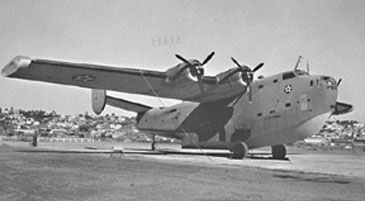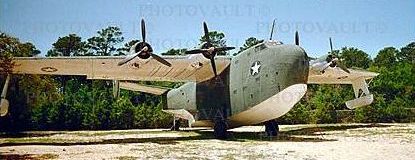|
||||||||||
|
|
||||||||||
|
||||||||||
|
|
||||||||||

However, the final production model, the PB2Y-5, was fitted with two different propellers. The outboard props were still 3-bladed, but those on the inboard engines had 4 blades each.

Unfortunately, we have not yet been able to determine for sure why these four-bladed props were used on the PB2Y-5. At first, we had theorized that the PB2Y-5 used two different engines whereas the earlier models had only been equipped with one. In that case, the two inboard engines must have been of greater power than the outboard ones. The reason that a more powerful engine would need more propeller blades is explained in another question.
However, we have continued to investigate this subject since answering that earlier question and new evidence suggests that our theory was not correct. First we contacted Joe Baugher who has put together an excellent Encyclopedia of American Military Aircraft and is an authority on a wide variety of such planes. His data indicated that the PB2Y-5 was fitted with only a single make of engine, the Pratt & Whitney 1830-92 Twin Wasp radial piston. So this information put us back at square one.
Nevertheless, we have received messages from two visitors to our site offering possible explanations for the differing number of blades. John Reardon writes:
"On a recent visit to the Pensecola Air Museum, I saw a PB2Y-5 being restored. The guide pointed out the propellers and said there was a shortage of reversible propellers, so only 1 reversible propeller per side was used. I believe the 3-bladed would be reversible because it was on an outboard engine, but I was confused about which he said was reversible."The PB2Y-5 did indeed use reversible propellers (more accurately called reversible-pitch propellers) to assist in taxiing on water. The term "reversible-pitch" means that the blades are able to rotate along their axis. This motion allows the blades to change the angle of attack at which they meet the oncoming air so that they will produce more or less thrust depending on the new pitch angle. In particular, the blades can be rotated to a position where they produce high drag, or reverse thrust, to slow the aircraft down or make it easier to steer. Many land-based aircraft also use the same technique to reduce the runway length needed for landing (see a previous question on thrust reversing). In the case of the PB2Y-5, these reversible-pitch propellers gave the aircraft better maneuverability on water allowing it to taxi to pick up a buoy or steer its way to a floating gas dock. However, John is mistaken on the location of the reversing blades as it was actually the inboard engines that were so equipped. Thanks to Mike Rudderow who mailed us with information from his father, a PB2Y-5 crew member during World War II, confirming the use of these inboard reversible four-bladed propellers for improved steering on water.
Even so, Jaime Carreon of Jetmex's Aviation Page provides a slightly different take on the subject based on information he found at the US Navy Patrol Squadrons website. He writes:
"I believe the reason for the four blade props on the inboard engines and three bladers on the outboards was simply a matter of clearance from the prop tips to the fuselage. You'll notice the inboard props appear to be slightly smaller in diameter than the outboards. This was to prevent damage to the aircraft from spray thrown by the props on takeoff and landings."The site he references goes on to point out that the longer three-bladed propellers were located farther out on the wing and mounted higher above the water therefore making it unneccesary to replace them with four-bladed props.
So whether the use of the different propellers is due to blade length, a shortage of reversible-pitch propellers,
or both, these two explanations both seem feasible. If you have further information to help us
solve this mystery once and for all, please contact us.
- answer by Jeff Scott, 12 August 2001
Read More Articles:


|
Aircraft | Design | Ask Us | Shop | Search |

|
|
| About Us | Contact Us | Copyright © 1997-2023 | |||
|
|
|||